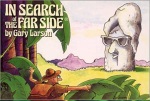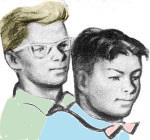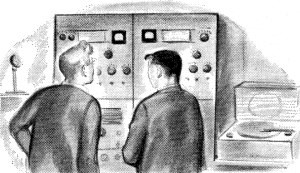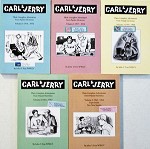Carl and Jerry: Wired Wireless
|
|||||||
BTW, get a load of Carl's Farside™-styled glasses. That was before they went out of style... way out of style. Carl and Jerry: Wired Wireless
Mind telling me why we're climbing to the sixth floor of Gary Hall?" Jerry puffed as he followed his athletic chum, Carl, up the stairs. "Jimmy Young, chief technical and maintenance engineer of WCCR, master station of the carrier-current campus radio network, wants to see us. And we've been itching to see the station. Need I say more?" Carl asked as he pushed open the door at the top of the stairs. A stocky, dark-complexioned young man rose from a chair across the large room and came to meet them. "You must be Jerry Bishop; and you, Carl Anderson," he said, holding out his hand. "I'm Jimmy Young. Thanks for coming. Want to take a quick look around the station before we get down to the little matter I have in mind?" "Yeah!" Carl and Jerry chorused. A grin spread over Jimmy's face as he brushed back his dark hair with his hand. "Okay, but first you gotta suffer through my two-dollar lecture," he warned. "You're now standing in the office and lounge of WCCR, master station of what we think is the oldest and largest carrier-current campus radio network in the world. There are four other stations in the net: WMRH in H1 Residence Hall, WHRC in H2, KMRX in H3, and WCTS in the State Street Courts. As soon as it's completed, we expect to add a sixth station, WGRC, in the Women's Residence Hall.
Each station is self-sufficient; it's constructed, maintained, and operated by students housed in that building, and it furnishes programs for the residents of that one housing unit. "At the same time, each satellite station is connected to the patch board of this master control station by a closed telephone loop so we can feed programs to it or it can furnish programs for the network. All five stations take turns furnishing network programs. A simplex telephone circuit in connection with each telephone loop permits exchanging information about programing, etc. "Now, let's go into Studio A, our master control room." The boys followed him through the door, and the first thing that caught their eyes was a couple of standard six-foot racks filled with electronic equipment. A control console, two turntables, tape recorders, an AM-FM tuner, and other assorted pieces of equipment were arranged for maximum convenience. "I'll talk about WCCR," Jimmy announced, "for it's the oldest and most sophisticated station, and it's the one I know the most about; but the basic transmitters of the other stations are similar. This is the station for Gary Hall, often called the Men's Quadrangle because it actually consists of six residence halls arranged in a rectangle. Power circuits for the Quadrangle are fed from six different power boxes furnishing 220 volts single phase a.c.; so we have to feed our r.f. into each of these boxes." "Must take lots of r.f.," Carl said. "How many kilowatts do you run ?" "We use two separate transmitters here at WCCR so we can transmit the same program on two different frequencies and provide stereo reception, but each transmitter inputs only about 30 watts! In fact, the transmitters are revamped Heathkit DX-35's. We put in new oscillator coils and plate-tank pi-networks designed to have a satisfactory Q at a low, broadcast-band frequency, and to feed a 72-ohm coax line. These transmitters are plate-modulated in each case by a pair of 5881's in Class AB driven by a 12AX7 as a combination amplifier and phase-inverter." "Then what's the rest of that stuff?" Carl asked, waving at the big racks. "Preamplifiers, monitor amplifiers, cue amplifiers, limiter amplifiers, patch board, power supplies, and other little goodies needed to transmit really high quality programs and to serve as a master control station. Our preamps and line amps are flat from 10 cycles to 25,000 cycles, but we restrict the high end to 9000 cycles and boost the bass before feeding the signal to the modulator. We do this to prevent splatter and to compensate for the poor low-frequency response of the small radios used to receive us." "You say you run two different r.f. signals into your single 'antenna,' the power lines, when you're operating stereo," Jerry commented. "How do you prevent interaction between the two transmitters ?" "We use what we call a hybrid junction. This is similar to the diplexer unit a TV station employs to feed both the audio and video transmitters into the same antenna. Actually, it's a form of r.f. bridge that permits each transmitter to feed the line but prevents r.f. from backing up into the other transmitter." "How do you actually couple into the power boxes?" Carl wanted to know at this point. "We use an r.f. transformer for each box. The primary is tapped so we can hook several in parallel and still get a proper impedance for our 72-ohm line. Each side of the secondary goes through an 0.0005 blocking capacitor and a 10-ohm, 5-watt resistor to one side of the 220-volt line. The capacitor, of course, keeps the 60-cycle a.c. out of the transformer winding. "We've found that the impedance from one side of the power line to ground varies between 1/4 and 1/2 ohm at our carrier frequency as different devices in the building are switched on or off. Naturally a two-to-one change in load impedance would badly upset any established match; but when the resistor is inserted, the impedance seen by half the transformer secondary can only vary between 5 1/4 and 5 1/2 ohms, and that can be tolerated. Lots of power is lost in the resistors, but we've enough left." "Can you pick up the program on a transistor radio in one of the rooms, or does the radio have to be plugged into the line?" Carl asked. "You know you can pick it up on any kind of radio; so stop pulling my leg! In fact, you can receive it with only a pair of earphones clipped across a 1N34 diode. Remember, you're practically sitting on the antenna, for every wire in the building is radiating r.f. for a short distance." "What hours do you operate?" Jerry questioned.
"Do you get permission to rebroadcast their programs?" "Yes, although strictly speaking we wouldn't have to. We're not rebroadcasting. Our wired-wireless is actually just a big p.a. system." "Do you do any live shows?" Jerry asked. "Oh, sure. We do interviews in our studios here, and we do remote pickups from all over the campus. We may do a poolside program from the Co-Rec Gym during a swimming meet; we may broadcast a baseball game; or we may work remote from a record hop, or dance, or any other spot calculated to stir up interest among our listeners. Our patch board is connected to that of the university broadcast station by a permanent loop, and sometimes they let us use their remote lines when we're doing a remote show. But let's take a look at the rest of the station. "Here, next door, is Studio C, which is just an announcing studio. Studio B, over there to the left, has a console and turntables, and is set up as a control room for monophonic work. On down the hall is our record library - we have 5000 45's and about 2000 LP's in there, and among the latter are many of the finest classical records. We're starting to stock up on stereophonic records and tapes now, for the fellows seem to like our stereo programs." "Where do you get the money for all this?" Carl asked bluntly. "As you know," Jimmy replied, "each residence hall has its own social organization or club. You automatically join this club when you take up residence and are charged a membership fee of $15 a year to pay for social activities, music groups, camera club, residence-hall radio station, etc. Each station prepares a budget each year and receives a certain amount of the club dues to pay for records, maintenance, and new equipment." "Those studios must be soundproofed," Carl remarked as he watched the lips of an announcer in Studio C moving but heard no sound. "They are. The walls are double-studded, and each wall contains two layers of acoustical wall tile, two layers of Celotex, and two 2" layers of star foam. The glass partition windows have double panes set in rubber so they can't conduct sound. Over here, next to the stairs, is our lab and workshop where we build and test our equipment. You see we have the usual meters, signal generators, and 'scope ... "Say, fellows, I'd like to go into more detail, but I'm running out of time. Suppose we go over to the desk and I tell you why I had you come up." They sat down at the desk, and Jimmy peered at them from beneath his heavy brows as he toyed with a set of keys fastened to his belt with a silver chain. "Some joker always tries to get into the act, and we have one here at Gary Hall," he said with a sigh. "For the past week someone in the southwest wing has been jamming our programs. He sits on the frequency, plays records, makes sarcastic remarks about our programs, and tries to get the listeners to tune to another frequency where he says he is going to put on a real program. "We thought he'd soon get tired and quit this foolishness, but apparently he's not going to; so we've got to find him and put a stop to it. Too many students are complaining that they're not getting much satisfaction out of the money they've paid for carrier-current entertainment." "How do you know the guy is in the southwest wing?" Carl quizzed. "That's the only place his signal is heard. Signals won't feed back through the r.f. transformers from one power box to the others." "Where do we come in?" Jerry asked. "We need some outsiders to help track the wildcatter down. Members of the WCCR staff are too well known here at Gary Hall; as soon as one of us steps into that southwest wing, the station goes off the air. But I hear you two are pretty good electronic technicians. Will you help?" "Sure, but how can we?" Carl wanted to know. Jimmy opened a drawer and took out a small transistorized tape recorder. A shielded cord ran from the microphone jack to a little black metal box with a small coil sticking out one end. "This is a ferrite-rod antenna coil tuned to the frequency of the wildcat station," Jimmy explained. "A crystal diode inside the box detects the signal picked up by the coil and feeds it to the recorder amplifier. With the monitoring earphone of the recorder, you can hear anything picked up by this r.f. probe and being recorded. "The wildcatter can't be running much power; so his signal should fall off rapidly on this insensitive detector as the distance from the room where he is feeding the signal into the line increases. I want you two to use this to spot his room; then call me, and the hall counselor and I will take it from there." "When ?" Carl asked. "In about ten minutes, if you will. He comes on every evening at four, and it's nearly that now. We'll play piano music from four until four-fifteen so you can tell his station from ours. Then I'll fake a station breakdown so you'll have his signal in the clear. Okay?" Before they quite knew what they were doing, Carl and Jerry found themselves walking down the hall on the second floor of the west wing of the Quadrangle. They tried to saunter along very non-chalantly, but they felt as conspicuous as a couple of skunks at a perfume manufacturers' convention. The recorder was humming away in Jerry's overcoat pocket, and his turned-up coat collar concealed the earphone. "I'm hearing both stations," he muttered to Carl. "The joker's rock-and-roll is beginning to drown out the piano. We must be getting close. He's stronger on this side of the hall. Oh, oh! There goes the piano music off. The wildcat station is really getting loud now, but keep walking. Now it's beginning to fall off. Let's turn around. "Right here it's the loudest. He's talking now. Pretend to show me something in that math book while I take this earphone out of my ear. Say! I can hear him talking through the ventilator at the same time I hear him on the earphone. This is the room. Call Jimmy while I keep the recorder going." Carl called from a telephone booth in the hall, and in only a few minutes Jimmy came dashing up with another young man. They took the tape recorder, listened to the sounds coming from the ventilator, and then knocked at the door. Carl and Jerry walked on down the hall as the door finally opened and two flustered-looking youths let Jimmy and the counselor in. Fifteen minutes later, the door opened again, and Jimmy and the counselor emerged. They were carrying a small 45-rpm record player and what the two boys recognized as being a wireless phono-oscillator. "Well, fellows, there goes our wildcat radio station," Jimmy said as he joined them and the three started for the stairs. "When they heard the tape recording, they broke down and confessed. The equipment has been confiscated, and I'm pretty sure we won't have any more of that sort of thing. And I certainly want to thank you for helping. I've got to scamper back and put the station on the air again now, but I'll see you around." Big lazy snowflakes started drifting down as Carl and Jerry walked briskly toward H3 in the gathering darkness. The patterns of lighted windows in the residence halls looked warm and friendly. "Say, Carl," Jerry suddenly exclaimed, "I like being part of a school where the students can design and build and maintain and operate an elaborate radio network like that in their spare time-especially when we both know how precious little spare time they have." "Yeah, me too," Carl agreed. "I think we're in the right place."
Posted April 21, 2023
|
|||||||


 By John
T. Frye, W9EGV
By John
T. Frye, W9EGV  "Each station," he continued, "operates on a
selected crystal-controlled frequency somewhere between 570 and 660 kilocycles.
The r.f. from the transmitter is fed into the power circuits of the particular residence
unit so that any radio inside the building can pick up the program but no signal
can be heard outside.
"Each station," he continued, "operates on a
selected crystal-controlled frequency somewhere between 570 and 660 kilocycles.
The r.f. from the transmitter is fed into the power circuits of the particular residence
unit so that any radio inside the building can pick up the program but no signal
can be heard outside.  "We're on twenty-four hours a day, seven days
a week. We start with some rock-and-roll wake-up music around 7 :30 a.m. During
the rest of the morning we feature good-to-study-by music, not too distracting,
and a special lunch program of music is on during the noon hour. In the afternoon
we play 20 or 30 of the top records. Dinner music is on from 5:30 to 6:30, and after
dinner we have more pop tunes - but no rock-and-roll. From 9 until 11 it's semi-classical;
from 11 to 12 we have an hour of the very best classical music. Then we switch over
to the tuner bringing in one of the clear channel broadcast stations that operate
all night, and we ride that until morning."
"We're on twenty-four hours a day, seven days
a week. We start with some rock-and-roll wake-up music around 7 :30 a.m. During
the rest of the morning we feature good-to-study-by music, not too distracting,
and a special lunch program of music is on during the noon hour. In the afternoon
we play 20 or 30 of the top records. Dinner music is on from 5:30 to 6:30, and after
dinner we have more pop tunes - but no rock-and-roll. From 9 until 11 it's semi-classical;
from 11 to 12 we have an hour of the very best classical music. Then we switch over
to the tuner bringing in one of the clear channel broadcast stations that operate
all night, and we ride that until morning."  Carl & Jerry, by John T. Frye
Carl & Jerry, by John T. Frye